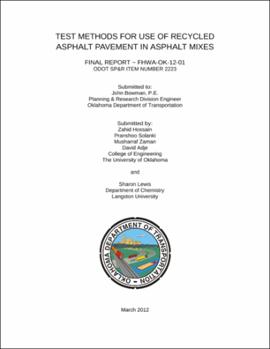| dc.description.abstract | Usage of recycled asphalt pavement (RAP) in the construction of new pavements has increased in recent years due to the movement to conserve energy and raw materials, and reuse waste materials. To assess the effectiveness of RAP materials in new asphalt mixes, it is important to evaluate the properties of the recovered binders and aggregates. The widely used “Abson” method is employed in this study to recover asphalt binder from RAP. Also, the frequently used “NCAT Ignition” method is used to extract aggregates. A laboratory study comprising of two field RAP materials, four simulated RAP materials and corresponding virgin materials, was undertaken to assess possible influences of the aforementioned recovery processes. Gradation, specific gravity, durability (L.A. Abrasion and Micro-Deval), sand equivalent, and insoluble residue of the extracted aggregates, and performance grade (PG), viscosity and penetration values of the recovered binders were evaluated as per the AASHTO and Oklahoma Department of Transportation (ODOT) standards. It was observed that gradation, specific gravity, durability and sand equivalent of the extracted aggregate were inconsistent with their virgin counterparts, and would result in conservative designs in a majority of cases. On the other hand, acid solubility, percentage of crushed face and surface properties were not influenced by the NCAT ignition oven processes. Binder test results showed that the Abson method positively influenced the critical PG temperatures of the recovered binder by about 4oC. The Abson method did not show any statistically significant influence on the viscosity values of the recovered binders at ODOT mixing and compaction temperatures. The penetration test results of recovered binder via the Abson method were found to be higher than laboratory aged binder in 75% of the time. In regard to the PG grade, based on limited test results, the Abson method is less conservative than the Rotavapor method. The findings of this study are expected to be helpful in the evaluation of RAP for reuse in asphalt paving. | |
